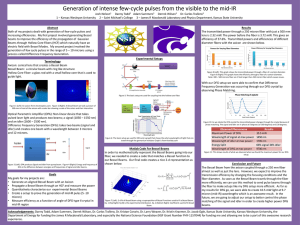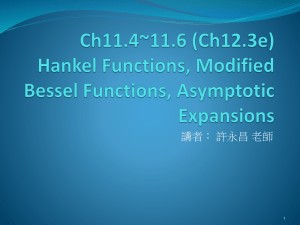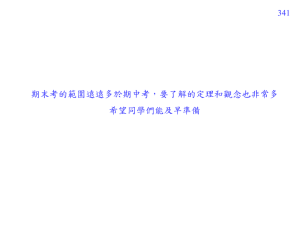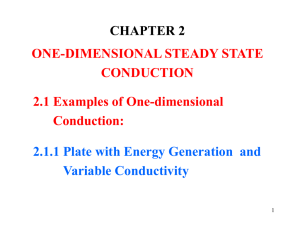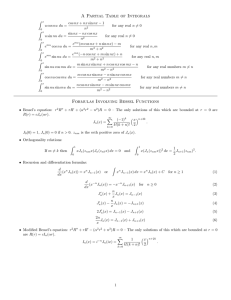Bessel
advertisement
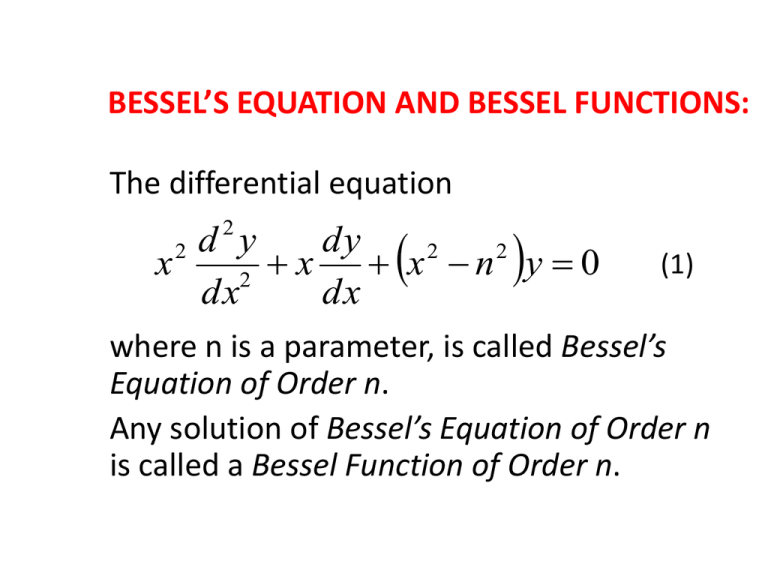
BESSEL’S EQUATION AND BESSEL FUNCTIONS: The differential equation 2 d y dy 2 2 2 x x x n y 0 2 dx dx (1) where n is a parameter, is called Bessel’s Equation of Order n. Any solution of Bessel’s Equation of Order n is called a Bessel Function of Order n. Bessel’s Equation and Bessel’s Functions occur in connection with many problems of physics and engineering, and there is an extensive literature dealing with the theory and application of this equation and its solutions. If n=0 Equation (1) is equivalent to the equation 2 d y dy x xy 0 2 dx dx (2) which is called Bessel’s Equation of Order Zero. The general Solution of Equation (2) is given by : y A J 0 ( x) B Y0 ( x) where A and B are arbitrary constants, and J 0 is called the Bessel Function of the First Kind of Order Zero. Y0 is called the Bessel Function of the Second Kind of Order Zero. The functions J0 and Y0 have been studied extensively and tabulated. Many of the interesting properties of these functions are indicated by their graphs. The general Solution of Equation (1) is given by : y A J n ( x) B Yn ( x) where A and B are arbitrary constants, and J n is called the Bessel Function of the First Kind of Order n. Bessel Functions of the first kind of order n is called the Gamma Function (n) t n 1 t 0 e dt for n 0 (n 1) n(n) (n 1) n! ; if n 0,1,2,.....where 0! 1 (n 1) ( n) for n0 n Bessel Functions of the first kind of order n For n=0,1 we have Y is called the Bessel Function of the Second Kind of Order n. n is Euler’s Constant and is defined by 1 1 1 lim1 ... ln n 0.5772 n n 2 3 For n=0 General Solution of Bessel Differential Equation Generating Function for Jn(x) Recurrence Formulas forBessel Functions Bessel Functions of Order Equal to Half and Odd Integer In this case the functions are expressible in terms of sines and cosines. For further results use the recurrence formula. Bessels Modified Differential Equations Solutions of this equation are called modified Bessel functions of order n. Modified Bessels Functions of the First Kind of Order n Modified Bessels Functions of the First Kind of Order n Modified Bessels Functions of the First Kind of Order n Modified Bessels Functions of the Second Kind of Order n Modified Bessels Functions of the Second Kind of Order n Modified Bessels Functions of the Second Kind of Order n General Solution of Bessel’s Modified Equation Generating Function for In(x) Recurrence Formulas for Modified Bessel Functions Recurrence Formulas for Modified Bessel Functions Modified Bessel Functions of Order Equal to Half and Odd Integer In this case the functions are expressible in terms of hyperbolic sines and cosines. Modified Bessel Functions of Order Equal to Half and Odd Integer For further results use the recurrence formula. Results for are obtained from Modified Bessel Functions of Order Equal to Half and Odd Integer Graphs of Bessel Functions J 0 (0) 1 J 1 ( 0) 0 Y0 (0) Y1 (0) I1 (0) 0 I o (0) 1 K 0 (0) K1 (0) Indefinite Integrals Involving Bessel Functions Indefinite Integrals Involving Bessel Functions Indefinite Integrals Involving Bessel Functions Indefinite Integrals Involving Bessel Functions Definite Integrals Involving Bessel Functions Definite Integrals Involving Bessel Functions A General Differential Equation Having Bessel Functions as Solutions Many differential equations occur in practice that are not of the standars form but whose solutions can be written in terms of Bessel functions. A General Differential Equation Having Bessel Functions as Solutions The differential equation 2 2 2 1 2a a p c c 1 2 y y bcx y 0 2 x x has the solution y x Z p (bx ) a c Where Z stands for J and Y or any linear combination of them, and a, b, c, p are constants. Example Solve y’’+9xy=0 Solution: 1 2a 0; (bc) 2 9; 2(c 1) 1; a 2 p 2c 2 0 From these equations we find a 1 / 2; c 3 / 2; b 2; p a / c 1/ 3 Then the solution of the equation is y x1/ 2 Z1/ 3 (2x3/ 2 ) This means that the general solution of the equation is y x [ AJ1/ 3 (2x ) BY1/ 3 (2x ) 1/ 2 3/ 2 where A and B are constants 3/ 2 A General Differential Equation Having Bessel Functions as Solutions The differential equation p x y x(a 2bx ) y 2 c dx 2q b(a p 1) x b x p 2 2p y 0 If (1 a2 ) 4c and d and p or q is not zero has the solution p x yx e AZ (x ) BZ (x ) q q 1 a ; 2 b ; p d q ; (1 a) 4c 2q 2 d Z Z 0 d 0 J J 0 d 0 J Y 0 d 0 I I 0 d 0 I K A General Differential Equation Having Bessel Functions as Solutions The differential equation d r dy s r 2 x ax bx y 0 dx dx If (1 r ) 4b and sr 2 or b 2 2 has the solution y x AZ (x ) BZ (x ) 1 r ; 2 2r s ; 2 2 a 2r s ; (1 r ) 4b 2r s 2 a Z Z 0 a 0 J J 0 a 0 J Y 0 a0 I I 0 a0 I K Problem A pipe of radius R0 has a circular fin of radius R1 and thickness 2B on it (as shown in the figure below). The outside wall temperature of the pipe is Tw and the ambient air temperature is Ta. Neglect the heat loss from the edge of the fin (of thickness 2B). Assume heat is transferred to the ambient air by surface convection with a constant heat transfer coefficient h. • a) Starting with a shell thermal energy balance, derive the differential equation that describes the radial temperature distribution in the fin. • b) Obtain the radial temperature distribution in the circular fin. • c) Develop an expression for the total heat loss from the fin. Solution From a thermal energy balance over a thin cylindrical ring of width Dr in the circular fin, we get Rate of Heat In - Out + Generation = Accumulation The accumulation term (at steady-state) and the generation term will be zero. So, (2pr 2Bqr ) r (2pr 2Bqr ) r Dr 2(2prDr)h(T Ta ) 0 where h is the (constant) heat transfer coefficient for surface convection to the ambient air and qr is the heat flux for conduction in the radial direction. Dividing by 4p B Dr and taking the limit as Dr tends to zero, lim Dr 0 (rqr ) r Dr (rqr ) Dr r h r (T Ta ) B d h (rqr ) r (T Ta ) dr B If the thermal conductivity k of the fin material is considered constant, on substituting Fourier’s law we get d dT h (r ) r (T Ta ) dr dr kB Let the dimensionless excess temperature be denoted by q = (T - Ta)/(Tw - Ta). Then, d dq h (r ) rq 0 dr dr kB d r dy s r 2 x ax bx y 0 dx dx r 1; s 1; b 0; a h /(kB) (1 r ) 4b 1 1 0 4(0) 2 2 and s r 2 0; 1; 11 2 a 0 q AI ( a x) q x 0 AZ 0 ( a x) BZ 0 ( a x) 0 a x) BK 0 (
